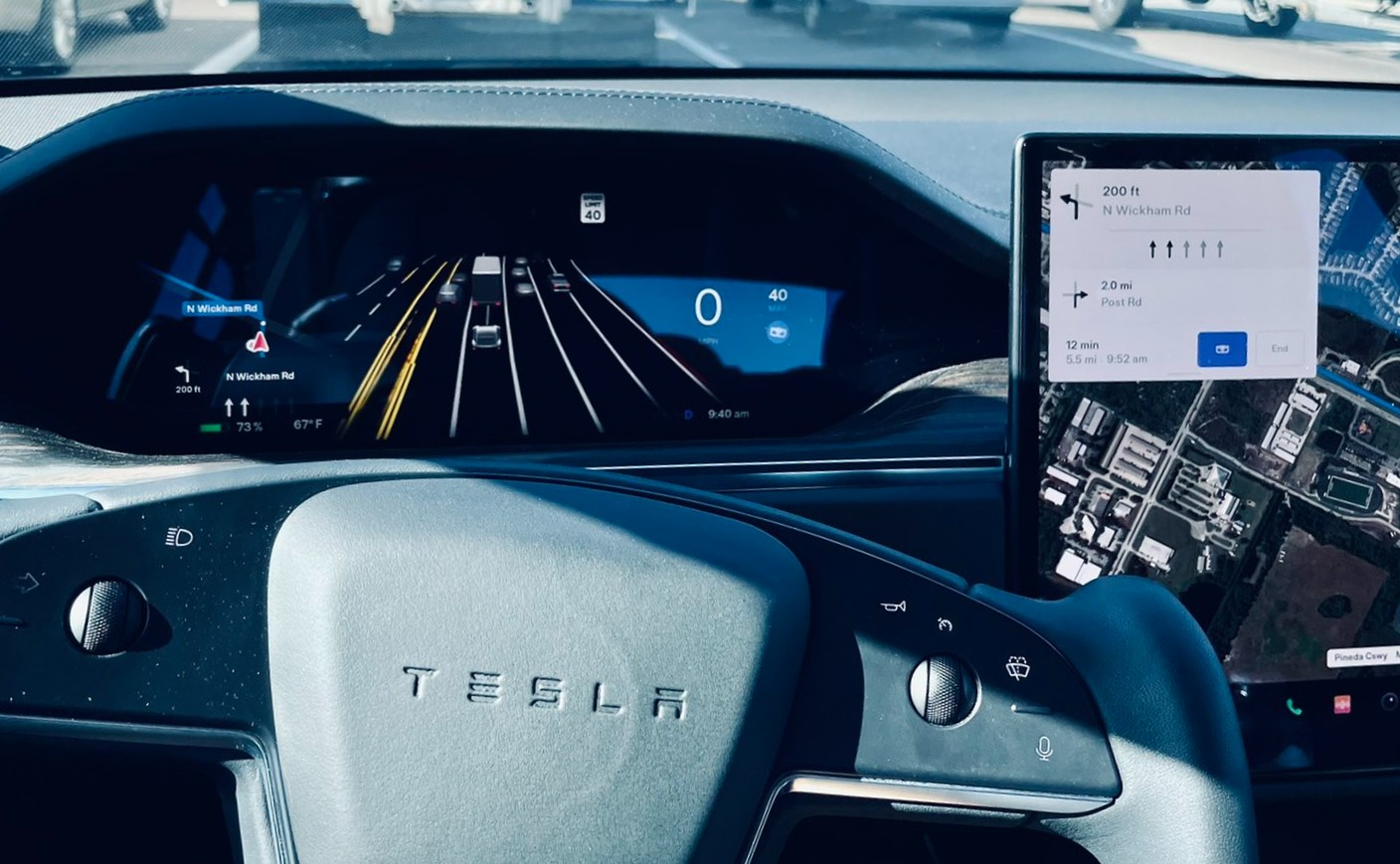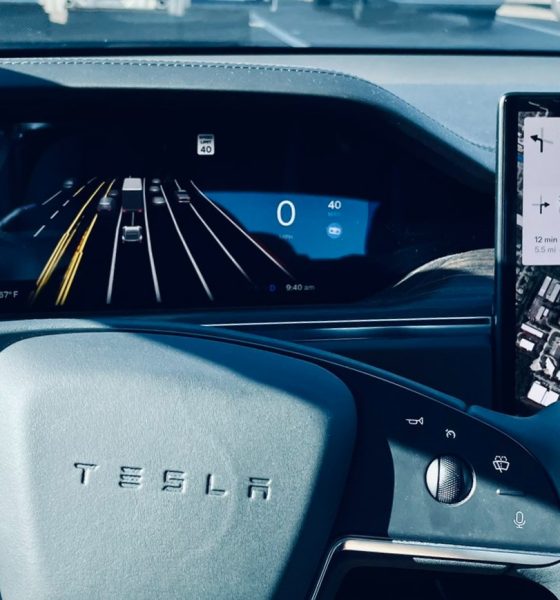

News
Tesla starts disabling FSD Beta’s “rolling stop” feature with V10.10 update
Just as indicated in the National Highway Traffic Safety Administration’s (NHTSA) Safety Recall Report, Tesla has started rolling out an over-the-air software update that removes FSD Beta’s ability to perform “rolling stops.” The function was deemed by the NHTSA as a driving behavior that may increase the risk of collisions.
Images of FSD Beta 10.10’s release notes were recently shared online, hinting that the company is now actively addressing the issue outlined in the recent recall. It remains to be seen how long it would take Tesla to update its FSD Beta fleet to the new v10.10 software, especially since there are now nearly 60,000 drivers who are part of the early access program.
Following are the release notes of FSD Beta 10.10.
Early Access Program – FSD Beta 10.10
– Smoother fork maneuvers and turn-lane selection using high fidelity trajectory primitives.
– Disabled rolling-stop functionality in all FSD Profiles. This behavior used to allow the vehicle to roll through all-way-stop intersections, but only when several conditions were met, including: vehicle speed less than 5.6 mph, no relevant objects/pedestrians/bicyclists detected, sufficient visibility and all entering roads at the intersection have speed limits below 30 mph.
– Improved generalized static object network by 4% using improved ground truth trajectories.
– Improved smoothness when stopping for crossing objects at intersections by modeling soft and hard constraints to better represent urgency of the slowdown.
– Enabled lane changing into an oncoming lane to maneuver around static obstacles, when safe to do so.
– Improved smoothness for merge handling by enforcing more consistency with previous cycle’s speed control decisions.
– Improved handling of flashing red light traffic controls by adding more caution for events where crossing vehicles may not stop.
– Improved right of way understanding at intersections with better modeling of intersection extents.
A look at FSD Beta 10.10’s release notes suggests that Tesla’s “rolling stop” feature was not really as aggressive or dangerous as initially feared by critics. As noted by the company, FSD Beta’s “rolling stops” are only enabled when several conditions are met, and those conditions are fairly conservative. Tesla’s FSD Beta safety record would support this thesis, as the company noted in the NHTSA’s Safety Recall Report that it was not aware or any warranty claims, field reports, crashes, injuries, or fatalities that resulted from the advanced driver-assist system’s “rolling stop” function. “As of January 27, 2022, Tesla is not aware of any warranty claims, field reports, crashes, injuries or fatalities related to this condition,” the NHTSA’s report read.
While the removal of FSD Beta’s “rolling stop” feature was considered a recall of over 53,000 Teslas, the fact remains that the issue was completely addressed through a simple over-the-air update. Owners whose vehicles were part of the recall were also not required to do anything specific except to ensure that their vehicles were connected to the internet. This was something that was highlighted in the remedy for the issue indicated in the NHTSA’s Safety Recall Report.
“Tesla will disable the ‘rolling stop’ functionality on affected vehicles, starting with firmware release 2021.44.30.15. Firmware release 2021.44.30.15 is expected to begin deployment OTA to affected vehicles in early February 2022. The disablement will carry forward in firmware release 2021.44.30.15 and later releases. No further action is necessary from owners who install firmware release 2021.44.30.15 or a later release on their vehicles,” the NHTSA’s Safety Recall Report read.
Don’t hesitate to contact us with news tips. Just send a message to simon@teslarati.com to give us a heads up.

Elon Musk
Elon Musk’s X will start using a Tesla-like software update strategy
The initiative seems designed to accelerate updates to the social media platform, while maintaining maximum transparency.

Elon Musk’s social media platform X will adopt a Tesla-esque approach to software updates for its algorithm.
The initiative seems designed to accelerate updates to the social media platform, while maintaining maximum transparency.
X’s updates to its updates
As per Musk in a post on X, the social media company will be making a new algorithm to determine what organic and advertising posts are recommended to users. These updates would then be repeated every four weeks.
“We will make the new 𝕏 algorithm, including all code used to determine what organic and advertising posts are recommended to users, open source in 7 days. This will be repeated every 4 weeks, with comprehensive developer notes, to help you understand what changed,” Musk wrote in his post.
The initiative somewhat mirrors Tesla’s over-the-air update model, where vehicle software is regularly refined and pushed to users with detailed release notes. This should allow users to better understand the details of X’s every update and foster a healthy feedback loop for the social media platform.
xAI and X
X, formerly Twitter, has been acquired by Elon Musk’s artificial intelligence startup, xAI last year. Since then, xAI has seen a rapid rise in valuation. Following the company’s the company’s upsized $20 billion Series E funding round, estimates now suggest that xAI is worth tens about $230 to $235 billion. That’s several times larger than Tesla when Elon Musk received his controversial 2018 CEO Performance Award.
As per xAI, the Series E funding round attracted a diverse group of investors, including Valor Equity Partners, Stepstone Group, Fidelity Management & Research Company, Qatar Investment Authority, MGX, and Baron Capital Group, among others. Strategic partners NVIDIA and Cisco Investments also continued support for building the world’s largest GPU clusters.
News
Tesla FSD Supervised wins MotorTrend’s Best Driver Assistance Award
The decision marks a notable reversal for the publication from prior years, with judges citing major real-world improvements that pushed Tesla’s latest FSD software ahead of every competing ADAS system.

Tesla’s Full Self-Driving (Supervised) system has been named the best driver-assistance technology on the market, earning top honors at the 2026 MotorTrend Best Tech Awards.
The decision marks a notable reversal for the publication from prior years, with judges citing major real-world improvements that pushed Tesla’s latest FSD software ahead of every competing ADAS system. And it wasn’t even close.
MotorTrend reverses course
MotorTrend awarded Tesla FSD (Supervised) its 2026 Best Tech Driver Assistance title after extensive testing of the latest v14 software. The publication acknowledged that it had previously criticized earlier versions of FSD for erratic behavior and near-miss incidents, ultimately favoring rivals such as GM’s Super Cruise in earlier evaluations.
According to MotorTrend, the newest iteration of FSD resolved many of those shortcomings. Testers said v14 showed far smoother behavior in complex urban scenarios, including unprotected left turns, traffic circles, emergency vehicles, and dense city streets. While the system still requires constant driver supervision, judges concluded that no other advanced driver-assistance system currently matches its breadth of capability.
Unlike rival systems that rely on combinations of cameras, radar, lidar, and mapped highways, Tesla’s FSD operates using a camera-only approach and is capable of driving on city streets, rural roads, and freeways. MotorTrend stated that pure utility, the ability to handle nearly all road types, ultimately separated FSD from competitors like Ford BlueCruise, GM Super Cruise, and BMW’s Highway Assistant.
High cost and high capability
MotorTrend also addressed FSD’s pricing, which remains significantly higher than rival systems. Tesla currently charges $8,000 for a one-time purchase or $99 per month for a subscription, compared with far lower upfront and subscription costs from other automakers. The publication noted that the premium is justified given FSD’s unmatched scope and continuous software evolution.
Safety remained a central focus of the evaluation. While testers reported collision-free operation over thousands of miles, they noted ongoing concerns around FSD’s configurable driving modes, including options that allow aggressive driving and speeds beyond posted limits. MotorTrend emphasized that, like all Level 2 systems, FSD still depends on a fully attentive human driver at all times.
Despite those caveats, the publication concluded that Tesla’s rapid software progress fundamentally reshaped the competitive landscape. For drivers seeking the most capable hands-on driver-assistance system available today, MotorTrend concluded Tesla FSD (Supervised) now stands alone at the top.
News
Elon Musk’s Grokipedia surges to 5.6M articles, almost 79% of English Wikipedia
The explosive growth marks a major milestone for the AI-powered online encyclopedia, which was launched by Elon Musk’s xAI just months ago.

Elon Musk’s Grokipedia has grown to an impressive 5,615,201 articles as of today, closing in on 79% of the English Wikipedia’s current total of 7,119,376 articles.
The explosive growth marks a major milestone for the AI-powered online encyclopedia, which was launched by Elon Musk’s xAI just months ago. Needless to say, it would only be a matter of time before Grokipedia exceeds English Wikipedia in sheer volume.
Grokipedia’s rapid growth
xAI’s vision for Grokipedia emphasizes neutrality, while Grok’s reasoning capabilities allow for fast drafting and fact-checking. When Elon Musk announced the initiative in late September 2025, he noted that Grokipedia would be an improvement to Wikipedia because it would be designed to avoid bias.
At the time, Musk noted that Grokipedia “is a necessary step towards the xAI goal of understanding the Universe.”
Grokipedia was launched in late October, and while xAI was careful to list it only as Version 0.1 at the time, the online encyclopedia immediately earned praise. Wikipedia co-founder Larry Sanger highlighted the project’s innovative approach, noting how it leverages AI to fill knowledge gaps and enable rapid updates. Netizens also observed how Grokipedia tends to present articles in a more objective manner compared to Wikipedia, which is edited by humans.
Elon Musk’s ambitious plans
With 5,615,201 total articles, Grokipedia has now grown to almost 79% of English Wikipedia’s article base. This is incredibly quick, though Grokipedia remains text-only for now. xAI, for its part, has now updated the online encyclopedia’s iteration to v0.2.
Elon Musk has shared bold ideas for Grokipedia, including sending a record of the entire knowledge base to space as part of xAI’s mission to preserve and expand human understanding. At some point, Musk stated that Grokipedia will be renamed to Encyclopedia Galactica, and it will be sent to the cosmos.
“When Grokipedia is good enough (long way to go), we will change the name to Encyclopedia Galactica. It will be an open source distillation of all knowledge, including audio, images and video. Join xAI to help build the sci-fi version of the Library of Alexandria!” Musk wrote, adding in a later post that “Copies will be etched in stone and sent to the Moon, Mars and beyond. This time, it will not be lost.”








